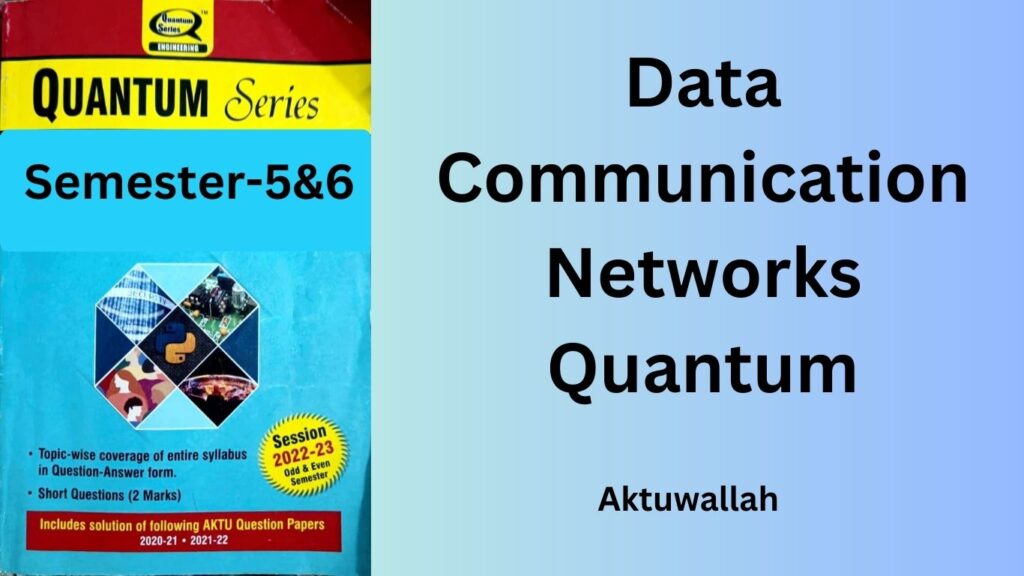Download Data Communication Networks Quantum Pdf For Aktu B-tech 3rd Year:
Are you interested in learning about data communication networks? Look no further! In this article, we will provide you with a brief overview of data communication networks, along with a downloadable Data Communication Networks Quantum Pdf that covers the key topics. Whether you’re a student, professional, or simply curious about the subject, this article will equip you with valuable knowledge. So let’s dive in!
How to download Data Communication Networks Quantum Pdf for free?
Click at the following button to download pdf file.
GET PDF
Download other quantum pdf for Aktu B-tech 3rd year: Click Here
Download Aktu Syllabus of B-tech 3rd year: Click Here
Download Handwritten Notes of all subjects: Click Here
Download Data Communication Networks PYQs: Click Here
Visit AKTU official site to explore more
Key to covered in Data Communication Networks Quantum Pdf
Table of Contents
- Introduction to Data Communication Networks Quantum Pdf
- Types of Data Communication Networks
- Network Topologies
- Transmission Media
- Network Protocols
- Network Security
- Wireless Networks
- Internet of Things (IoT)
- Cloud Computing and Networking
- Future Trends in Data Communication Networks
- Conclusion
Introduction to Data Communication Networks Quantum Pdf
In this section, we will provide an introduction to data communication networks. Data communication networks are systems that allow the transfer of information between devices or nodes. These networks facilitate the exchange of data through various means, such as wired or wireless connections.
Types of Data Communication Networks
Data communication networks can be categorized into different types based on their scope and purpose. Some common types include local area networks (LANs), wide area networks (WANs), metropolitan area networks (MANs), and personal area networks (PANs). Each type serves a specific range of users and geographical area.
Network Topologies
Network topologies refer to the physical or logical arrangement of nodes in a network. Common topologies include bus, star, ring, mesh, and hybrid. Each topology has its advantages and disadvantages, and the choice depends on factors such as scalability, fault tolerance, and cost.
Transmission Media
Transmission media are the channels through which data is transmitted in a network. They can be wired or wireless. Wired media include twisted-pair cables, coaxial cables, and fiber-optic cables. Wireless media include radio waves, microwaves, and infrared signals. The selection of transmission media depends on factors such as data rate, distance, and interference.
Network Protocols
Network protocols are a set of rules and standards that govern the communication between devices in a network. They ensure that data is transmitted accurately and reliably. Examples of network protocols include TCP/IP, Ethernet, and Wi-Fi. These protocols define how data is formatted, addressed, transmitted, and received.
Network Security
Network security is a critical aspect of data communication networks. It involves protecting network resources and data from unauthorized access, attacks, and vulnerabilities. Security measures include firewalls, encryption, authentication, and intrusion detection systems. Maintaining a secure network is essential to prevent data breaches and ensure the privacy of users.
Wireless Networks
Wireless networks have gained significant popularity due to their convenience and flexibility. They use wireless signals to transmit data between devices. Wi-Fi, Bluetooth, and cellular networks are examples of wireless networks. They enable mobile connectivity and have revolutionized the way we access information and communicate.
Internet of Things (IoT)
The Internet of Things (IoT) is a network of interconnected devices embedded with sensors, software, and connectivity capabilities. These devices can communicate and exchange data with each other over the internet. IoT has transformed various industries, including healthcare, transportation, and smart homes. It offers numerous benefits but also poses challenges related to security and privacy.
Cloud Computing and Networking
Cloud computing and networking have revolutionized the storage and processing of data. Cloud services provide on-demand access to computing resources and enable data storage, software deployment, and virtualization. Cloud networks are designed to handle massive amounts of data and offer scalability and cost-effectiveness.
Future Trends in Data Communication Networks
Data communication networks continue to evolve and adapt to emerging technologies. Some future trends include the adoption of 5G networks, the integration of artificial intelligence (AI) in network management, the expansion of edge computing, and the development of quantum networks. These advancements will shape the future of data communication networks and offer new possibilities.
Conclusion
In conclusion, data communication networks play a crucial role in enabling the transfer of information between devices. Understanding the key concepts and topics in this field is essential for anyone interested in technology and networking. We hope this article has provided you with a comprehensive overview of data communication networks. To further enhance your knowledge, we have prepared Data Communication Networks Quantum Pdf that covers these topics in more detail.
1 thought on “Download Data Communication Networks Quantum PDF”